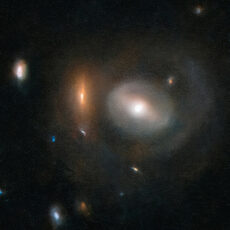
NASA / ESA’s Hubble Space Telescope observes an interacting galaxy system known as Arp-Madore 2105-332, which is located approximately 200 million light-years from Earth in the constellation Microscopium. This system is positioned in such away that the smaller galaxies appear to be forming a line that approaches the leftmost component of Arp-Madore 2105-332, known individually as 2MASX J21080752-3314337.

If you look closer at the pair of interacting galaxies, one smaller than the other, each features a bright spot at the center as well as two loosely-wound spiral arms, with threads of dark dust following the arms. They appear as a broad, soft glow, making it hard to identify individual stars, while a number of bright stars and smaller background galaxies can also be seen.
- LEGO NASA Space Set - This adult LEGO set features the Space Shuttle Discovery and the Hubble Space Telescope from NASA’s 1990 STS-31 mission,...
- Solar System Exploration - Unlock the mysteries of our solar system with this engaging 2,354-piece project, packed with authentic details and...
- Shuttle Features Galore - The space shuttle model has an opening payload bay, retractable landing gear, opening cockpit, moving elevons, space arm,...
As with many galaxy types, categorising a galaxy as an emission-line galaxy does not exclude it from having other descriptions that refer to its other properties. Arp-Madore 2105-332, for example, is also a ‘peculiar’ galaxy, reflecting the atypical shapes of its two constituent galaxies,” said the ESA.
[Source]










